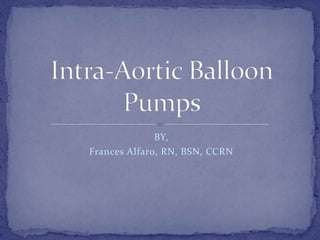Intra aortic balloon pumps
- 1. BY, Frances Alfaro, RN, BSN, CCRN
- 3. (Reid & Cottrell, 2005)
- 4. This is where the IABP is placed in the aorta.
- 5. ď‚— There are many complications that the nurse must be aware of including: ď‚— Ischemia of the limb ď‚— Compartment syndrome of the extremity being used ď‚— Dissected aorta ď‚— Catheter migration ď‚— Bleeding ď‚— Balloon rupture ď‚— Infection ď‚— Skin breakdown
- 6. ď‚— Most of these complications are life threatening to the patient. ď‚— The nurse must: ď‚— Assess the patient frequently for any of these complications, at least every 2 hours. ď‚— Notify the doctor immediately if any complications are seen. ď‚— Document accurately. ď‚— Have a good working Doppler available.
- 7. ď‚— Reid, M. B., & Cottrell, D. (2005). Nursing care of patients receiving: Intra-aortic balloon counterpulsation. Critical Care Nurse. Retrieved from http://ccn.aacnjournals.org/content/25/5/40.full






